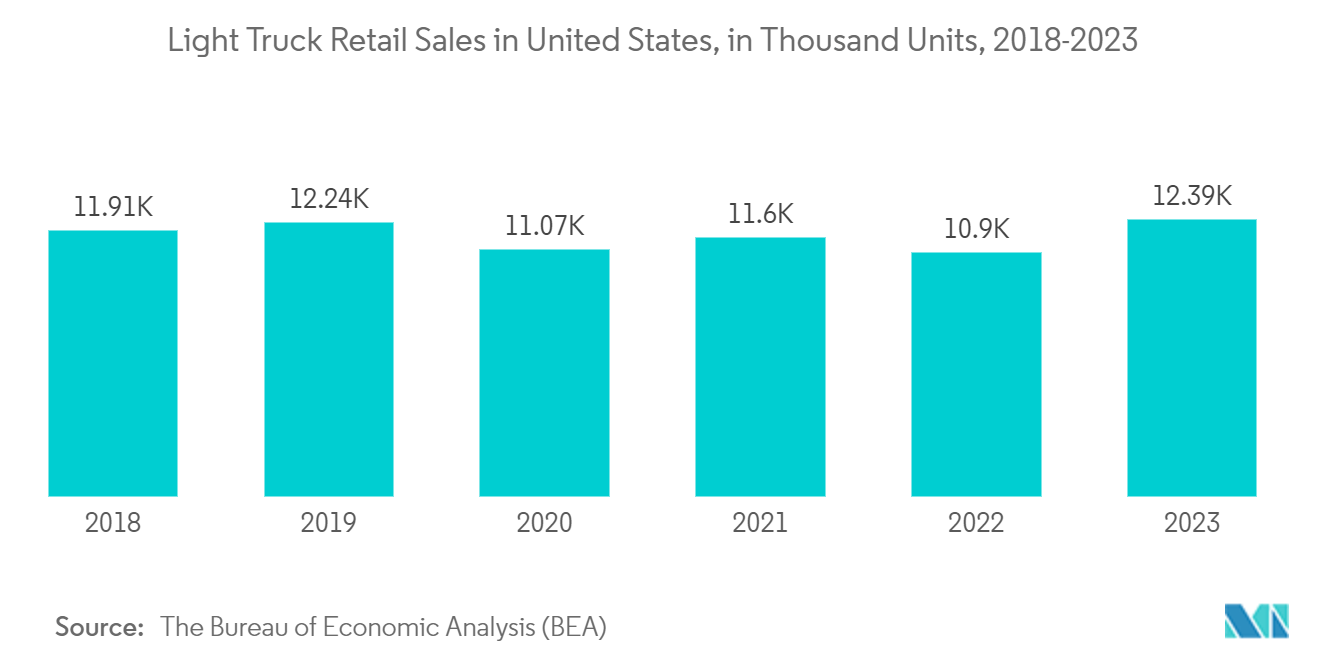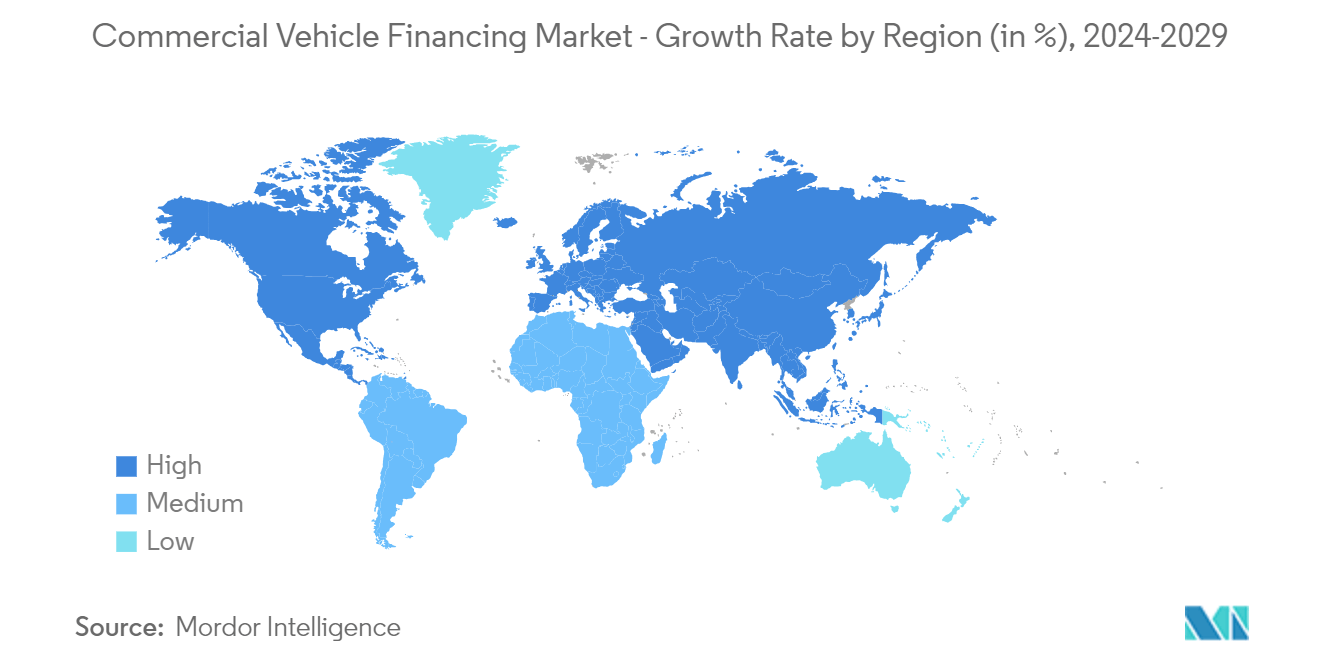Market Trends of Commercial Vehicle Financing Industry
The Light Commercial Vehicle Segment is Expected to Gain Traction Between 2024 and 2029
The rising preference for food delivery services and other e-commerce activities is fueling the demand for pickup trucks and vans, which is positively impacting the growth of this segment. E-commerce or fleet operators excessively prefer purchasing light commercial vehicles to expand their fleet, which requires them to spend hefty sums to purchase advanced models. Therefore, the preference to avail of loan and leasing solutions becomes the norm for these operators.
- According to the European Automobile Manufacturers' Association, new van registration across the European Union in the first three quarters of 2023 stood at 1.08 million units compared to 944.7 thousand units in Q1 to Q3 2022, representing a Y-o-Y growth of 14.3% between the first nine months of 2023 and 2022.
- According to the Bureau of Economic Analysis (BEA), the United States light truck retail sales touched 12,385.8 thousand units in 2023 compared to 10.895.8 thousand units in 2022, witnessing a Y-o-Y growth of 6.8% between 2022 and 2023.
Further, the aggressive push by the government across the world to promote the adoption of electric light commercial vehicles is assisting in expanding the market for electric LCVs. As the market for EVs witnesses surging growth in the coming years, there will exist a need for auto financing services with lower interest rates, as financing forms a major component of consumers’ purchasing preferences. Various automakers operating in the ecosystem are also launching advanced new-energy models to cater to the increasing demand, which is further contributing to the demand for light commercial vehicle financing services.
- In February 2024, Hyundai Motor Company and Iveco Group announced the signing of a supply agreement for an IVECO-badged all-electric light commercial vehicle for Europe based on Hyundai’s Global eLCV platform. Further, the company stated that the new vehicle will join Iveco Group’s electric light commercial vehicle lineup, enhancing the Group’s LCV portfolio alongside the iconic IVECO Daily. The IVECO-badged vehicle will be the first export model to apply Hyundai’s new Global all-electric Light Commercial Vehicle (eLCV) platform, a dedicated global EV platform made for commercial vehicles ranging from GVW 2.5 tons to 3.5 tons.
- In February 2024, EKA, a leading player in the electric mobility sector, with Mitsui Co Ltd (Japan) and VDL Groep (Netherlands) as equity partners, launched the 1.5-tonne electric light commercial vehicles (LCVs), featuring 300 volts electrical system architecture. The new model launched can be customized for various purposes, making it ideal for last-mile delivery, e-commerce logistics, and temperature-sensitive shipments.
The increasing demand for used light commercial vehicles owing to the preference of operators to purchase lower-priced vehicles is fostering the demand for financing for this segment. Various non-banking financial companies (NBFCs) and original equipment manufacturers (OEMs) operating in the ecosystem are extending financing services to enhance consumers' convenience. Further, these players are also extending leasing solutions for those customers who do not want to purchase a vehicle. With the increasing LCV demand, the market for light commercial vehicle financing is expected to showcase surging growth between 2024 and 2029.

Asia-Pacific is Expected to be the Fastest Growing Market Between 2024 and 2029
The growing population and rapid urbanization rate in Asia-Pacific are leading to consumers shifting to urban areas for better financial and employment opportunities, which is assisting the growing per capita disposable income. With the growing per capita disposable income of consumers, there exists a massive demand for commodities and products across the region, which is positively impacting the demand for commercial vehicle financing attributed to the expanding e-commerce and road freight sector.
- According to NITI Aayog, a government-aided think tank in India, heavy-duty trucks accounted for 76% of the overall road freight transportation in India, followed by medium-duty trucks contributing to a share of 21% in 2022.
- According to the Ministry of Transport of China, the volume of road freight traffic in China reached 6,895.8 billion ton-kilometers in 2022 compared to 6,908.77 billion ton-kilometers in 2021.
Moreover, the rising penetration of electric commercial vehicles in the region, coupled with the growing sales of commercial vehicles, leads to the surging demand for commercial vehicle financing options as fleet operators prefer to purchase expensive vehicles at lower interest rates. Several financial institutions customize their financing offerings to suit the regional and local demand in countries such as China and India. The integration of NBFCs and small finance banks in these countries also facilitates the growth of the commercial vehicle financing market across Asia-Pacific.
- According to the Society of Indian Automobile Manufacturers Association (SIAM), the overall commercial vehicle sales in India increased from 7,16,566 to 9,62,468 units in FY 2022-23 compared to the previous year. Similarly, sales of medium and heavy commercial vehicles increased from 2,40,577 to 3,59,003 units during the same period.
- According to the International Organization of Motor Vehicle Manufacturers (OICA), new commercial vehicle registrations in Japan stood at 753.02 thousand units in 2022 compared to 772.64 thousand units in 2021.
With the increasing investment in the construction sector and the government's focus on infrastructure development, there will exist a massive demand for heavy-duty trucks across Asia-Pacific, attributed to its requirement to transport raw materials, which is expected to contribute to the commercial vehicle financing market between 2024 and 2029. The Asia-Pacific market is also anticipated to witness players competing on the basis of parameters such as lower interest rates and higher repayment periods.


